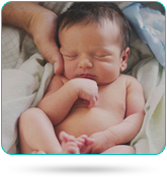Treating Infertility
A variety of options are now available to help identify the cause(s) of infertility and ultimately provide couples with the highest chance of realising their dream of having a baby.
The good news is that the majority of infertile couples who seek help eventually have a baby. Pregnancy rates for Assisted Reproductive Technology (ART) now exceed the monthly fertility rate for most "fertile" couples. But to achieve this, it may be necessary to have repeated treatments. So the earlier treatment is sought, the more likely the chance of a successful conception.
Treatment options
The procedures and treatments available from infertility clinics can be divided into four main categories:
- Hormonal and anti-oestrogen therapy (includes induction of ovulation)
- Artificial insemination (AI) procedures
- Surgery
- Assisted reproductive technology (ART)
The infertility specialist is likely to start with the simplest treatment that is suitable for the cause of infertility in a particular couple. Where a pregnancy is not achieved after a few cycles of treatment another procedure will be selected. Between 85% and 90% of infertility cases are treated with conventional medical therapies such as medication or surgery.
Hormonal therapy
Its objective is to replace, or enhance, the hormones produced naturally by the body. Gonadotropin treatment is also used to stimulate "super-ovulation" for assisted conception procedures, including in-vitro fertilisation (IVF).
Ovulation induction
Ovulation induction can be used as a treatment on its own or in combination with another infertility treatment such as artificial insemination or IVF.
The treatment stimulates ovulation in women with infrequent or irregular periods, or in those whose menstrual cycles have stopped due to polycystic ovaries. Although successful for many women, they carry a high risk of multiple pregnancies.
Artificial insemination
Most often used in cases of infertility due to low sperm count or reduced motility, the procedure can also be used in cases where the woman has hostile cervical mucus, or produces antibodies against sperm. The sperm cells are collected, processed and washed and then inserted directly into the uterus, cervical canal or vagina.
Surgery
Surgery can be used to correct anatomical abnormalities of the reproductive system in either the woman or the man.
Assisted Reproductive Technology
ART is a general term covering a range of advanced procedures, including micro-manipulation of sperm, to aid fertilisation and implantation. The procedures all have one thing in common: they require the collection of multiple mature eggs (oocytes), which is achieved by hormonal stimulation of the ovaries often described as "super-ovulation".
The main ART procedures include:
- In-vitro fertilisation (IVF)
- Intracytoplasmic sperm injection (ICSI) - for male infertility
- Gamete intrafallopian tube transfer (GIFT)
- Zygote intrafallopian transfer (ZIFT)
- Blastocyst transfer (BT)




